Iris (1914)
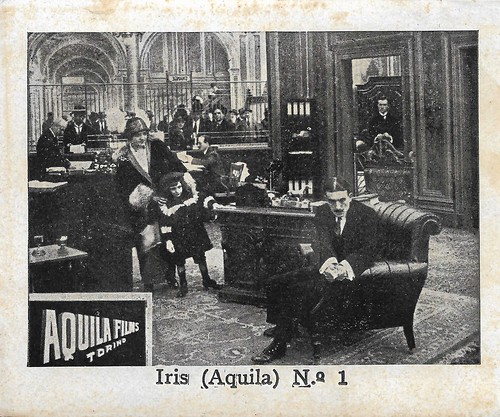
Spanish collectors card by Chocolate Amatller, Barcelona, no. 1 of 6. Photo: Aquila Films. Scene from Iris (Achille Consalvi, 1914).

Spanish collectors card by Chocolate Amatller, Barcelona, no. 2 of 6. Photo: Aquila Films. Scene from Iris (Achille Consalvi, 1914).

Spanish collectors card by Chocolate Amatller, Barcelona, no. 3 of 6. Photo: Aquila Films. Scene from Iris (Achille Consalvi, 1914).
A fraudulent, criminal bank cashier who becomes a murderer
Iris (Achille Consalvi, 1914) starts with a fraudulent, criminal bank cashier, who fakes a robbery at the bank in order to save himself from ruin. Discovered by a night watch, he kills the man.
After twenty years, Arturo, the son of the cashier, falls in love with the daughter of the murdered night watch, Iris, who has become an acclaimed actress. He spends large sums to impress his girlfriend and asks his mother for money. The mother lives abroad in a villa.
The homicidal husband suddenly shows up again and is informed by a ragpicker how to best rob the villa of his wife, helped by the crony's little girl. When his lamp goes off during the robbery and he hits a piece of furniture, the wife is alarmed and almost killed by her own man. The girl assists in the killing and is so terrified she falls ill.
Yet, it is the lady's son Arturo who is accused of the failed homicide. Instead, Iris, taking care of the girl, finds with her a note from the ragpicker explaining who is the real culprit. During a stage show in honour of Iris, the thief invites Iris to a party, where she unmasks him as the culprit. In the end, he dies from a bomb.
It is unknown who were the actors in this film. Iris was released in Italy in May 1914. The plot is deducted from a review of the film in the journal La Vita Cinematografica.

Spanish collectors card by Chocolate Amatller, Barcelona, no. 4 of 6. Photo: Aquila Films. Scene from Iris (Achille Consalvi, 1914).

Spanish collectors card by Chocolate Amatller, Barcelona, no. 6 of 6. Photo: Aquila Films. Scene from Iris (Achille Consalvi, 1914).
La corsa all'abisso (1914)

Spanish collectors card by Reclam Films, Mallorca, no. 1 of 6. Photo: Milano Films. Mercedes Brignone and Antonio De Vergillius in La corsa all'abisso/The Pace That Kills (Attilio Fabbri, 1914).

Spanish collectors card by Reclam Films, Mallorca, no. 2 of 6. Photo: Milano Films. Duel in La corsa all'abisso/The Pace That Kills (Attilio Fabbri, 1914).
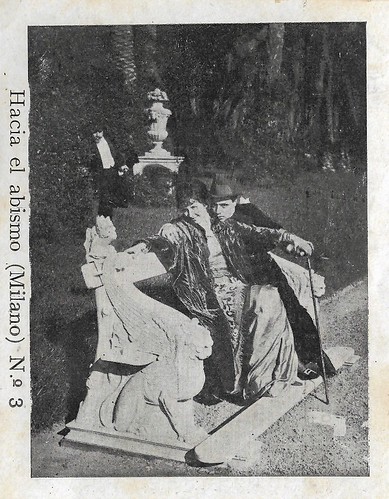
Spanish collectors card by Reclam Films, Mallorca, no. 3 of 6. Photo: Milano Films. Scene of La corsa all'abisso/The Pace That Kills (Attilio Fabbri, 1914).
Fatally pushed towards the abyss of rejection and misery
Italian actress Mercedes Brignone stars in the drama La corsa all'abisso/The Pace That Kills (Attilio Fabbri, 1914) as Lydia.
At the time of the premiere, the journal Il Maggese Cinematografico wrote that Lydia, a poor girl who once became like a dragonfly, lets herself be burned by the lamp of illusion.
In the end, she dies in the arms of her former lover, a poor artist, who really loved her and lived in the dark, but whom she, blinded by the corrupting light, had discarded, and thus was fatally pushed towards the abyss of rejection and misery.
Il Maggese Cinematografico predicted that even the most sceptical souls would be touched by this death scene. Both Il Maggese Cinematografico and La Vita Cinematografica praised the performance knowing well to perform the merry ingenuity as well as the fright and grief of the protagonist.
Attilio De Virgiliis played Brignone's rich lover, while the poor painter may have been played by Camillo Apolloni. The cinematography was by Carlo Montuori.

Spanish collectors card by Reclam Films, Mallorca, no. 4 of 6. Photo: Milano Films. Mercedes Brignone and Attilio De Virgiliis in La corsa all'abisso/The Pace That Kills (Attilio Fabbri, 1914).

Spanish collectors card by Reclam Films, Mallorca, no. 5 of 6. Photo: Milano Films. Mercedes Brignone in La corsa all'abisso/The Pace That Kills (Attilio Fabbri, 1914).
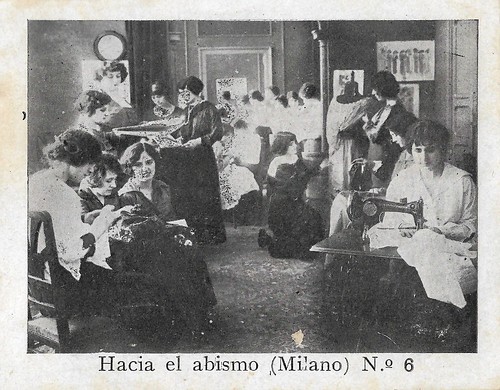
Spanish collectors card by Reclam Films, Mallorca, no. 6 of 6. Photo: Milano Films. Scene from La corsa all'abisso/The Pace That Kills (Attilio Fabbri, 1914).
'La dama del Castillo Negro' (S.A.)
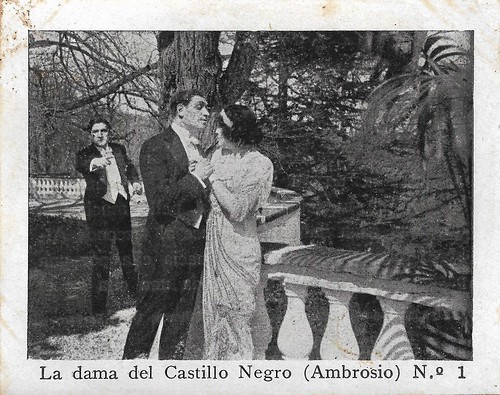
Spanish collector's card by Reclam Film, Mallorca, no. 1 of 6. Photo: Ambrosio. La dama del Castillo Negro is the Spanish title of a hitherto unidentified Italian production.

Spanish collector's card by Reclam Film, Mallorca, no. 2 of 6. Photo: Ambrosio. La dama del Castillo Negro is the Spanish title of a hitherto unidentified Italian production.
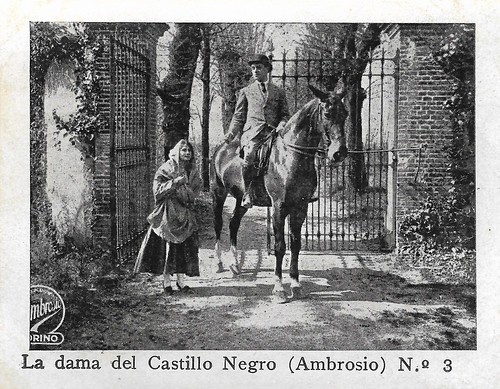
Spanish collector's card by Reclam Film, Mallorca, no. 3 of 6. Photo: Ambrosio. La dama del Castillo Negro is the Spanish title of a hitherto unidentified Italian production.
A rendezvous at the black castle
La dama del Castillo Negro is the Spanish title of a hitherto unidentified Italian production by Ambrosio Film from the early 1910s. We identified the leading actress Antonietta Calderari, as well as the actors Alfredo Bertone and Orlando Ricci.
In the plot on the cards, the main characters are named Sarha, the Prince of Koepic, Viscount Albert and policeman Harrison. The Prince of Koepic needs money and so his cousin Sarha (Antonietta Calderari) has to seduce Viscount Albert (Bertone).
Albert gives her a rendezvous at the black castle, where he is tied up and the prince asks his parents for a sum of 50,000 francs to free him. The prince's gang steals the sum and demands another 50,000, so the parents go to the policeman Harrison who goes to a hotel to catch the ring, but the prince sets fire to the hotel.
At a party, Harrison meets Sarha. Koepic finds out that Sarha is taking Harrison to the castle and so Koepic gets Harrison caught as well. Yet, Sarah has fallen so in love with Albert that Koepic wants to kill her. So she frees the two but they are pursued by Koepic and his gang. Sarah manages to throw the whole gang into a well, but as they fall, the prince shoots Sarah, who dies in the arms of her Albert.

Spanish collector's card by Reclam Film, Mallorca, no. 4 of 6. La dama del Castillo Negro is the Spanish title of a hitherto unidentified Italian production by Ambrosio Film from the early 1910s.
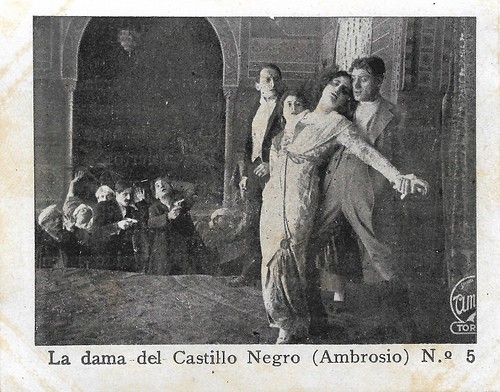
Spanish collector's card by Reclam Film, Mallorca, no. 5 of 6. La dama del Castillo Negro is the Spanish title of a hitherto unidentified Italian production by Ambrosio Film from the early 1910s.

Spanish collector's card by Reclam Film, Mallorca, no. 6 of 6. La dama del Castillo Negro is the Spanish title of a hitherto unidentified Italian production by Ambrosio Film from the early 1910s.
Fra uomini e belve (1913)

Spanish collectors card by Reclam Films, Mallorca, no. 1 of 6. Photo: Cines. Fra uomini e belve (Avventure in India)/Between Savage and Tiger (Giulio Antamoro, 1913). These Indian atmospheres were probably created at the Cines back lot.

Spanish collectors card by Reclam Films, Mallorca, no. 2 of 6. Photo: Cines. Scene from Fra uomini e belve (Avventure in India)/Between Savage and Tiger (Giulio Antamoro, 1913).

Spanish collectors card by Reclam Films, Mallorca, no. 3 of 6. Photo: Cines. Fra uomini e belve (Avventure in India)/Between Savage and Tiger (Giulio Antamoro, 1913). Hesperia saves her daughter from the evil Casuli (Ugone Di Sandri).
Strange adventures in India
In the Cines production Fra uomini e belve (Avventure in India)/Between Savage and Tiger (Giulio Antamoro, 1913), the stars are Amleto Novelli, Hesperia, Ignazio Lupi, and Lea Giunchi.
Amleto Novelli plays lieutenant Sandro Novelli, who even if not guilty, feels responsible after a disastrous explosion in gunpowder storage. He leaves for India, leaving his wife Hesperia (Hesperia) and little Bebé behind. His skills as a hunter are recognised by an Indian, who asks for his carabine. When Novelli refuses, he is tied to a stake to be burned alive, but the medicine man offers him salvation if he saves the chief from sickness, which he manages to do so.
The tribe honours him and the chief's daughter Sarama (Lea Giunchi) falls in love with him. Meanwhile, anxious because without news, Hesperia boards a ship with her daughter. A fire breaks out but Tom (Ignazio Lupi), an old sea wolf saves them, while the ship sinks.
After many adventures, Hesperia, Bebé and old Tom reach Novelli. Sarama, jealous of the marital bliss, exposes Bebé to a tiger, but old Tom saves the situation once more. Novelli flees with his family but is pursued by the Indians. He tricks them by putting puppets on the horses.
Yet, the grim lover of Samara, Casuli/Casali (Ugone Di Sandri), discovers the ruse, but after a fierce battle in which Hesperia shows her courage, the family manages to flee and return to Italy.

Spanish collectors card by Reclam Films, Mallorca, no. 4 of 6. Photo: Cines. Fra uomini e belve (Avventure in India)/Between Savage and Tiger (Giulio Antamoro, 1913). Little Bebé threatened by a tiger, sent by Samara.

Spanish collectors card by Reclam Films, Mallorca, no. 5 of 6. Photo: Cines. Amleto Novelli to be burned alive in Fra uomini e belve (Avventure in India)/Between Savage and Tiger (Giulio Antamoro, 1913).

Spanish collectors card by Reclam Films, Mallorca, no. 6 of 6. Photo: Cines. Fra uomini e belve (Avventure in India)/Between Savage and Tiger (Giulio Antamoro, 1913).
Sources: Aldo Bernardini & Vittorio Martinelli, Il cinema muto italiano, 1913, Vol. I, and Vittorio Martinelli, Il cinema muto italiano, 1914, Vol. I.
No comments:
Post a Comment